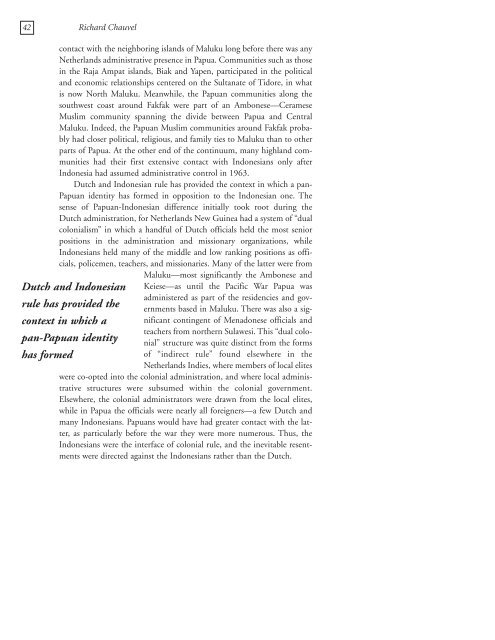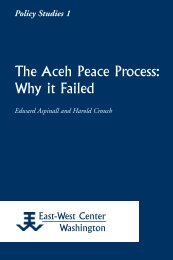Constructing Papuan Nationalism: History, Ethnicity ... - ScholarSpace
Constructing Papuan Nationalism: History, Ethnicity ... - ScholarSpace
Constructing Papuan Nationalism: History, Ethnicity ... - ScholarSpace
- No tags were found...
Create successful ePaper yourself
Turn your PDF publications into a flip-book with our unique Google optimized e-Paper software.
42 Richard Chauvelcontact with the neighboring islands of Maluku long before there was anyNetherlands administrative presence in Papua. Communities such as thosein the Raja Ampat islands, Biak and Yapen, participated in the politicaland economic relationships centered on the Sultanate of Tidore, in whatis now North Maluku. Meanwhile, the <strong>Papuan</strong> communities along thesouthwest coast around Fakfak were part of an Ambonese––CerameseMuslim community spanning the divide between Papua and CentralMaluku. Indeed, the <strong>Papuan</strong> Muslim communities around Fakfak probablyhad closer political, religious, and family ties to Maluku than to otherparts of Papua. At the other end of the continuum, many highland communitieshad their first extensive contact with Indonesians only afterIndonesia had assumed administrative control in 1963.Dutch and Indonesian rule has provided the context in which a pan-<strong>Papuan</strong> identity has formed in opposition to the Indonesian one. Thesense of <strong>Papuan</strong>-Indonesian difference initially took root during theDutch administration, for Netherlands New Guinea had a system of “dualcolonialism” in which a handful of Dutch officials held the most seniorpositions in the administration and missionary organizations, whileIndonesians held many of the middle and low ranking positions as officials,policemen, teachers, and missionaries. Many of the latter were fromMaluku—most significantly the Ambonese andKeiese—as until the Pacific War Papua wasadministered as part of the residencies and governmentsbased in Maluku. There was also a significantcontingent of Menadonese officials andteachers from northern Sulawesi. This “dual colonial”structure was quite distinct from the formsof “indirect rule” found elsewhere in theNetherlands Indies, where members of local eliteswere co-opted into the colonial administration, and where local administrativestructures were subsumed within the colonial government.Elsewhere, the colonial administrators were drawn from the local elites,while in Papua the officials were nearly all foreigners—a few Dutch andmany Indonesians. <strong>Papuan</strong>s would have had greater contact with the latter,as particularly before the war they were more numerous. Thus, theIndonesians were the interface of colonial rule, and the inevitable resentmentswere directed against the Indonesians rather than the Dutch.Dutch and Indonesianrule has provided thecontext in which apan-<strong>Papuan</strong> identityhas formed
















